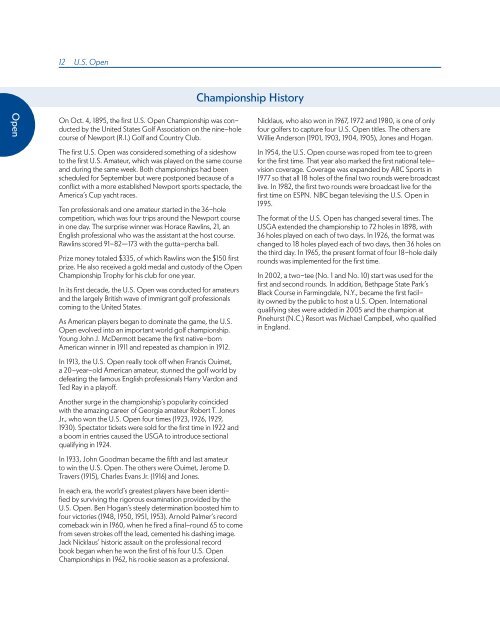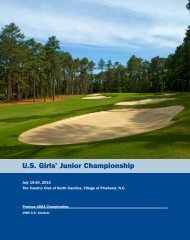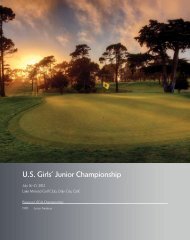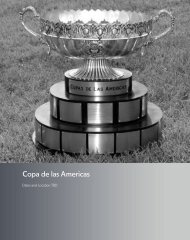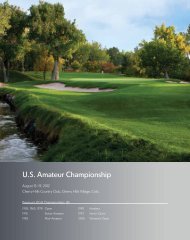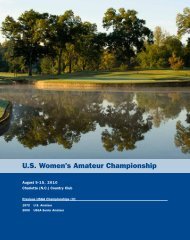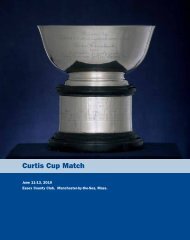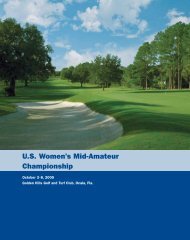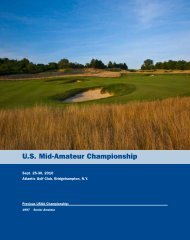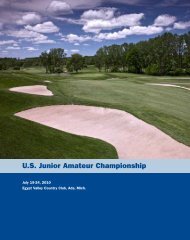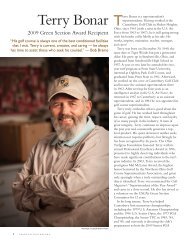- Page 1:
2012United States Golf AssociationC
- Page 4 and 5:
2 Table of ContentsTable of Content
- Page 6 and 7:
4 The USGAThe USGAThe United States
- Page 8 and 9:
6 The USGAGHIN (which stands for Go
- Page 10 and 11:
8 USGA Museum and Arnold Palmer Cen
- Page 12 and 13: 10 Bob Jones AwardThe 2012 Bob Jone
- Page 14 and 15: 12 Joe Dey AwardThe 2012 Joe Dey Aw
- Page 16 and 17: 14 Herbert Warren Wind Book AwardTh
- Page 18 and 19: 16 USGA Green Section AwardThe 2012
- Page 20 and 21: 18 Ike Grainger AwardThe 2011 Ike G
- Page 22 and 23: 20 USGA PresidentsUSGA Presidents18
- Page 24 and 25: 22 USGA Communications Staff Direct
- Page 26 and 27: 24 USGA Media RegulationsUSGA Media
- Page 28 and 29: 26 USGA Radio/Television/Internet R
- Page 30 and 31: Curtis Cup2010 Curtis Cup Match Cha
- Page 32 and 33: Curtis Cup4 Curtis Cup Match2012 Co
- Page 34 and 35: Curtis Cup6 Curtis Cup Match2010 Ma
- Page 36 and 37: Curtis Cup8 Curtis Cup MatchMatch H
- Page 38 and 39: Curtis Cup10 Curtis Cup Match1952 (
- Page 40 and 41: Curtis Cup12 Curtis Cup Match1976 (
- Page 42 and 43: Curtis Cup14 Curtis Cup Match2000 (
- Page 44 and 45: Curtis Cup16 Curtis Cup MatchUSA Cu
- Page 46 and 47: Curtis Cup18 Curtis Cup MatchName Y
- Page 48 and 49: Curtis Cup20 Curtis Cup MatchName Y
- Page 50 and 51: Curtis Cup22 Curtis Cup MatchCurtis
- Page 52 and 53: 2011 U.S. Open ChampionRory McIlroy
- Page 54 and 55: 4 U.S. Open2012 Conditions of PlayO
- Page 56 and 57: 6 U.S. OpenU.S. Open Media Informat
- Page 58 and 59: Open8 U.S. Open
- Page 60 and 61: 10 U.S. Open111th U.S. Open Champio
- Page 64 and 65: 14 U.S. OpenOpen1931 (July 2-4) Bil
- Page 66 and 67: 16 U.S. OpenOpen2008 (June 12-15) T
- Page 68 and 69: 18 U.S. OpenOpenAgeOldest Champion
- Page 70 and 71: 20 U.S. OpenOpenChampions Not Retur
- Page 72 and 73: 22 U.S. OpenOpenLowest Score, Last
- Page 74 and 75: 24 U.S. OpenOpenHighest Score by Wi
- Page 76 and 77: 26 U.S. OpenOpenMost Sub-Par Scores
- Page 78 and 79: 28 U.S. OpenOpenHoles-In-One (41)Ja
- Page 80 and 81: 30 U.S. OpenExemptions for Internat
- Page 83 and 84: WAPLU.S. Women’s AmateurPublic Li
- Page 85 and 86: U.S. Women’s Amateur Public Links
- Page 87 and 88: U.S. Women’s Amateur Public Links
- Page 89 and 90: U.S. Women’s Amateur Public Links
- Page 91 and 92: U.S. Women’s Amateur Public Links
- Page 93 and 94: U.S. Women’s Amateur Public Links
- Page 95 and 96: U.S. Women’s Amateur Public Links
- Page 97 and 98: U.S. Women’s Amateur Public Links
- Page 99 and 100: Women’sOpenU.S. Women’s Open Ch
- Page 101 and 102: U.S. Women’s Open 367th U.S. Wome
- Page 103 and 104: U.S. Women’s Open 5Ryu Wins the 2
- Page 105 and 106: U.S. Women’s Open 72011 Champions
- Page 107 and 108: U.S. Women’s Open 9Rd.1 Rd.2 Rd.3
- Page 109 and 110: U.S. Women’s Open 11Championship
- Page 111 and 112: U.S. Women’s Open 13U.S. Women’
- Page 113 and 114:
U.S. Women’s Open 15Winners of Wo
- Page 115 and 116:
U.S. Women’s Open 17Largest 18-Ho
- Page 117 and 118:
U.S. Women’s Open 19Foreign-Born
- Page 119 and 120:
APLU.S. Amateur Public Links Champi
- Page 121 and 122:
U.S. Amateur Public Links 387th U.S
- Page 123 and 124:
U.S. Amateur Public Links 5Mills Wi
- Page 125 and 126:
U.S. Amateur Public Links 7HoleParm
- Page 127 and 128:
U.S. Amateur Public Links 9June 27
- Page 129 and 130:
U.S. Amateur Public Links 11Champio
- Page 131 and 132:
U.S. Amateur Public Links 131955 (J
- Page 133 and 134:
U.S. Amateur Public Links 15U.S. AP
- Page 135 and 136:
U.S. Amateur Public Links 17Date Wi
- Page 137 and 138:
U.S. Amateur Public Links 1910 and
- Page 139 and 140:
SeniorOpenU.S. Senior Open Champion
- Page 141 and 142:
U.S. Senior Open 333rd U.S. Senior
- Page 143 and 144:
U.S. Senior Open 5• Any player wh
- Page 145 and 146:
U.S. Senior Open 72011 Championship
- Page 147 and 148:
U.S. Senior Open 9Rd.1 Rd.2 Rd.3 Fi
- Page 149 and 150:
U.S. Senior Open 11Championship Res
- Page 151 and 152:
U.S. Senior Open 13RecordsAgeOldest
- Page 153 and 154:
U.S. Senior Open 15Most Times Host
- Page 155 and 156:
U.S. Senior Open 17Lowest Score Und
- Page 157 and 158:
U.S. Senior Open 195 strokes Gary P
- Page 159 and 160:
U.S. Senior Open 21*Fewest Sub-Par
- Page 161 and 162:
U.S. Senior Open 23Hank Cooper, 3rd
- Page 163 and 164:
U.S. Girls’ Junior ChampionshipJu
- Page 165 and 166:
U.S. Girls’ Junior364th U.S. Girl
- Page 167 and 168:
U.S. Girls’ Junior5Jutanugarn Win
- Page 169 and 170:
U.S. Girls’ Junior7HoleParjutanug
- Page 171 and 172:
U.S. Girls’ Junior9July 18-23, Ol
- Page 173 and 174:
U.S. Girls’ Junior11Championship
- Page 175 and 176:
U.S. Girls’ Junior131982 (Aug. 9-
- Page 177 and 178:
U.S. Girls’ Junior1525 holes Vict
- Page 179 and 180:
U.S. Junior Amateur ChampionshipJul
- Page 181 and 182:
U.S. Junior Amateur365th U.S. Junio
- Page 183 and 184:
U.S. Junior Amateur5Spieth Wins the
- Page 185 and 186:
U.S. Junior Amateur7HoleParspiethba
- Page 187 and 188:
U.S. Junior Amateur9July 18-23, 201
- Page 189 and 190:
U.S. Junior Amateur11In 1948, the U
- Page 191 and 192:
U.S. Junior Amateur131982 (July 27-
- Page 193 and 194:
U.S. Junior Amateur159 and 8 Mitch
- Page 195 and 196:
U.S. Women’s Amateur Championship
- Page 197 and 198:
U.S. Women’s Amateur 3112th U.S.
- Page 199 and 200:
U.S. Women’s Amateur 5Kang Wins t
- Page 201 and 202:
U.S. Women’s Amateur 7HoleParKANG
- Page 203 and 204:
U.S. Women’s Amateur 9Aug. 8-14,
- Page 205 and 206:
U.S. Women’s Amateur 11Championsh
- Page 207 and 208:
U.S. Women’s Amateur 131926 (Sept
- Page 209 and 210:
U.S. Women’s Amateur 151996 (Aug.
- Page 211 and 212:
U.S. Women’s Amateur 17Winners of
- Page 213:
U.S. Women’s Amateur 1967 Jennife
- Page 216 and 217:
2011 U.S. Amateur ChampionKelly Kra
- Page 218 and 219:
Amateur4 U.S. Amateur2012 Condition
- Page 220 and 221:
Amateur6 U.S. Amateur
- Page 222 and 223:
Amateur8 U.S. Amateur111th U.S. Ama
- Page 224 and 225:
Amateur10 U.S. AmateurComplete Stro
- Page 226 and 227:
Amateur12 U.S. AmateurChampionship
- Page 228 and 229:
Amateur14 U.S. Amateur1928 (Sept. 1
- Page 230 and 231:
Amateur16 U.S. Amateur1999 (Aug. 16
- Page 232 and 233:
Amateur18 U.S. AmateurRecordsAgeOld
- Page 234 and 235:
Amateur20 U.S. AmateurLongest Final
- Page 237 and 238:
USGA Senior Women’s AmateurChampi
- Page 239 and 240:
USGA Senior Women’s Amateur 351st
- Page 241 and 242:
USGA Senior Women’s Amateur 5Terr
- Page 243 and 244:
USGA Senior Women’s Amateur 7The
- Page 245 and 246:
USGA Senior Women’s Amateur 9Sept
- Page 247 and 248:
USGA Senior Women’s Amateur 11The
- Page 249 and 250:
USGA Senior Women’s Amateur 13199
- Page 251 and 252:
USGA Senior Women’s Amateur 1569
- Page 253 and 254:
U.S. Mid-Amateur ChampionshipSept.
- Page 255 and 256:
U.S. Mid-Amateur 332nd U.S. Mid-Ama
- Page 257 and 258:
U.S. Mid-Amateur 5Lewis Wins the 20
- Page 259 and 260:
U.S. Mid-Amateur 7The Final: Lewis
- Page 261 and 262:
U.S. Mid-Amateur 9Sept. 17-22, 2011
- Page 263 and 264:
U.S. Mid-Amateur 1179sh-77th; Kenny
- Page 265 and 266:
U.S. Mid-Amateur 13Championship Res
- Page 267 and 268:
U.S. Mid-Amateur 15Companion Course
- Page 269 and 270:
U.S. Mid-Amateur 175 and 4 Bob Lewi
- Page 271 and 272:
USGA Men’s State Team Championshi
- Page 273 and 274:
USGA Men’s State Team 310th USGA
- Page 275 and 276:
USGA Men’s State Team 5Kansas Win
- Page 277 and 278:
USGA Men’s State Team 79th USGA M
- Page 279 and 280:
USGA Men’s State Team 9Position R
- Page 281 and 282:
USGA Men’s State Team 11Position
- Page 283 and 284:
USGA Men’s State Team 132001 (Sep
- Page 285 and 286:
USGA Men’s State Team 15RecordsMo
- Page 287 and 288:
WWATCWomen’s World Amateur TeamCh
- Page 289 and 290:
Women’s World Amateur Team 325th
- Page 291 and 292:
Women’s World Amateur Team 5Korea
- Page 293 and 294:
Women’s World Amateur Team 724th
- Page 295 and 296:
Women’s World Amateur Team 9Posit
- Page 297 and 298:
Women’s World Amateur Team 11Posi
- Page 299 and 300:
Women’s World Amateur Team 13Cham
- Page 301 and 302:
Women’s World Amateur Team 151980
- Page 303 and 304:
Women’s World Amateur Team 171996
- Page 305 and 306:
Women’s World Amateur Team 192008
- Page 307 and 308:
Women’s World Amateur Team 21Larg
- Page 309 and 310:
Women’s World Amateur Team 23152
- Page 311 and 312:
Women’s World Amateur Team 2570 H
- Page 313 and 314:
Women’s World Amateur Team 27Wome
- Page 315 and 316:
USGA Senior Amateur ChampionshipSep
- Page 317 and 318:
USGA Senior Amateur 358th USGA Seni
- Page 319 and 320:
USGA Senior Amateur 5Lee Wins the 2
- Page 321 and 322:
USGA Senior Amateur 7The Final: Ple
- Page 323 and 324:
USGA Senior Amateur 9Sept. 10-15, 2
- Page 325 and 326:
USGA Senior Amateur 11Championship
- Page 327 and 328:
USGA Senior Amateur 131985 (Sept. 3
- Page 329 and 330:
USGA Senior Amateur 158 and 7 Frede
- Page 331 and 332:
World Amateur Team ChampionshipOcto
- Page 333 and 334:
World Amateur Team 328th World Amat
- Page 335 and 336:
World Amateur Team 5France Wins the
- Page 337 and 338:
World Amateur Team 727th World Amat
- Page 339 and 340:
World Amateur Team 9PositionRd. 1 R
- Page 341 and 342:
World Amateur Team 11PositionRd. 1
- Page 343 and 344:
World Amateur Team 13PositionRd. 1
- Page 345 and 346:
World Amateur Team 151964 (Oct. 7-1
- Page 347 and 348:
World Amateur Team 171976 (Oct. 13-
- Page 349 and 350:
World Amateur Team 191990 (Oct. 25-
- Page 351 and 352:
World Amateur Team 212000 (Aug. 31
- Page 353 and 354:
World Amateur Team 232008 (Oct. 16-
- Page 355 and 356:
World Amateur Team 25Best Comeback
- Page 357 and 358:
World Amateur Team 27625 United Sta
- Page 359 and 360:
World Amateur Team 29140 United Sta
- Page 361 and 362:
World Amateur Team 31Lowest Score,
- Page 363 and 364:
World Amateur Team 33World Amateur
- Page 365:
World Amateur Team 35Jim Vernon, 20
- Page 368 and 369:
Women’sMid-Amateur2011 U.S. Women
- Page 370 and 371:
4 U.S. Women’s Mid-Amateur2012 Co
- Page 372 and 373:
Women’sMid-Amateur6 U.S. Women’
- Page 374 and 375:
8 U.S. Women’s Mid-Amateur25th U.
- Page 376 and 377:
10 U.S. Women’s Mid-AmateurComple
- Page 378 and 379:
12 U.S. Women’s Mid-AmateurChampi
- Page 380 and 381:
14 U.S. Women’s Mid-AmateurMost T
- Page 382 and 383:
2011 Walker Cup ChampionGreat Brita
- Page 384 and 385:
4 Walker Cup Match2013 Conditions o
- Page 386 and 387:
6 Walker Cup Match2011 Match NotesW
- Page 388 and 389:
8 Walker Cup MatchMatch HistoryThe
- Page 390 and 391:
10 Walker Cup MatchWalker Cup1932 (
- Page 392 and 393:
12 Walker Cup MatchWalker Cup1963 (
- Page 394 and 395:
14 Walker Cup MatchWalker Cup1987 (
- Page 396 and 397:
16 Walker Cup Match2011 (Sept. 10-1
- Page 398 and 399:
18 Walker Cup MatchWalker CupUSA Hi
- Page 400 and 401:
20 Walker Cup MatchUSA Walker Cup T
- Page 402 and 403:
22 Walker Cup MatchName Years playe
- Page 404 and 405:
24 Walker Cup MatchName Years playe
- Page 406 and 407:
26 Walker Cup MatchName Years playe
- Page 408 and 409:
28 Walker Cup MatchName Country Yea
- Page 410 and 411:
30 Walker Cup MatchName Country Yea
- Page 412 and 413:
32 Walker Cup MatchName Country Yea
- Page 414 and 415:
34 Walker Cup MatchUSA Walker Cup T
- Page 416 and 417:
36 Walker Cup MatchWalker Cup Capta
- Page 419 and 420:
Women’sState TeamUSGA Women’s S
- Page 421 and 422:
USGA Women’s State Team 310th USG
- Page 423 and 424:
USGA Women’s State Team 5Women’
- Page 425 and 426:
USGA Women’s State Team 7Women’
- Page 427 and 428:
USGA Women’s State Team 9Women’
- Page 429 and 430:
USGA Women’s State Team 11Women
- Page 431 and 432:
USGA Women’s State Team 13Women
- Page 433 and 434:
USGA Women’s State Team 15Women
- Page 435 and 436:
Copa de las AmericasDates and locat
- Page 437 and 438:
Copa de las Americas 35th Copa de l
- Page 439 and 440:
Copa de las Americas 5LeadersRound
- Page 441 and 442:
Copa de las Americas 77 puerto rico
- Page 443 and 444:
Copa de las Americas 9Championship
- Page 445 and 446:
Copa de las Americas 11All-Time Tot
- Page 447:
Copa de las Americas 13USA Copa de
- Page 450 and 451:
2 USGA SuperlativesUSGA Superlative
- Page 452 and 453:
4 USGA SuperlativesWomen’s Open;
- Page 454 and 455:
6 National ChampionsNational Champi
- Page 456 and 457:
8 National ChampionsCastillo, Lori
- Page 458 and 459:
10 National ChampionsFruhwirth, Amy
- Page 460 and 461:
12 National ChampionsJackson, Kathe
- Page 462 and 463:
14 National ChampionsName Total Yea
- Page 464 and 465:
16 National ChampionsPalmer, Ray 1
- Page 466 and 467:
18 National ChampionsName Total Yea
- Page 468 and 469:
20 National ChampionsName Total Yea
- Page 470 and 471:
22 Foreign-Born National ChampionsF
- Page 472 and 473:
24 Foreign-Born National ChampionsN
- Page 474 and 475:
26 Host States and ClubsHost States
- Page 476 and 477:
28 Host States and ClubsState & Clu
- Page 478 and 479:
30 Host States and ClubsState & Clu
- Page 480 and 481:
32 Host States and ClubsState & Clu
- Page 482 and 483:
34 Host States and ClubsState & Clu
- Page 484 and 485:
36 Host States and ClubsState & Clu
- Page 486 and 487:
38 Host States and ClubsState & Clu
- Page 488 and 489:
40 Host States and ClubsState & Clu
- Page 490 and 491:
42 Host States and ClubsState & Clu
- Page 492 and 493:
44 Host States and ClubsState & Clu
- Page 494 and 495:
46 Future Championships ChartUSGA F
- Page 496:
48 2012 Championships2012 2009 USGA


